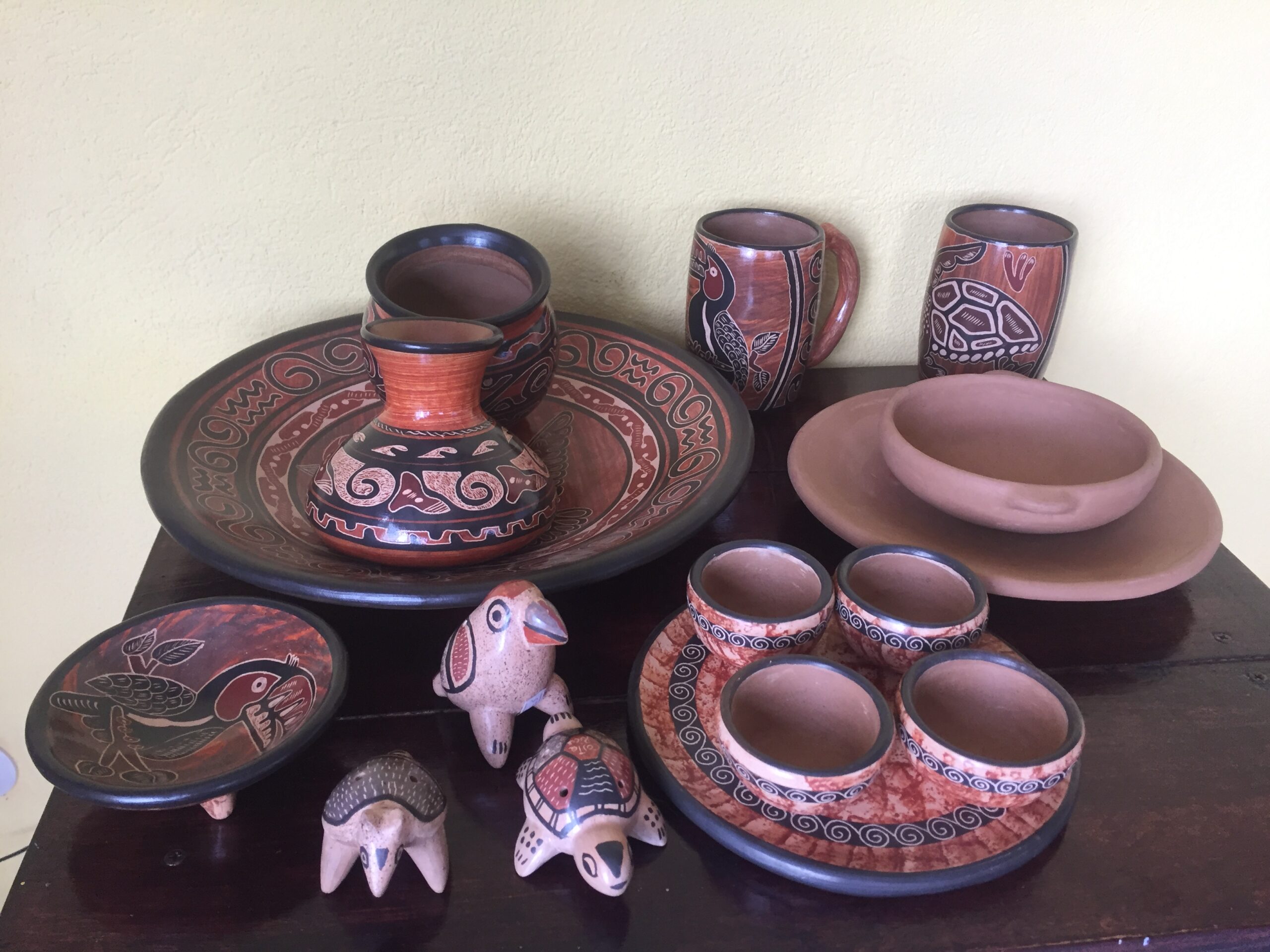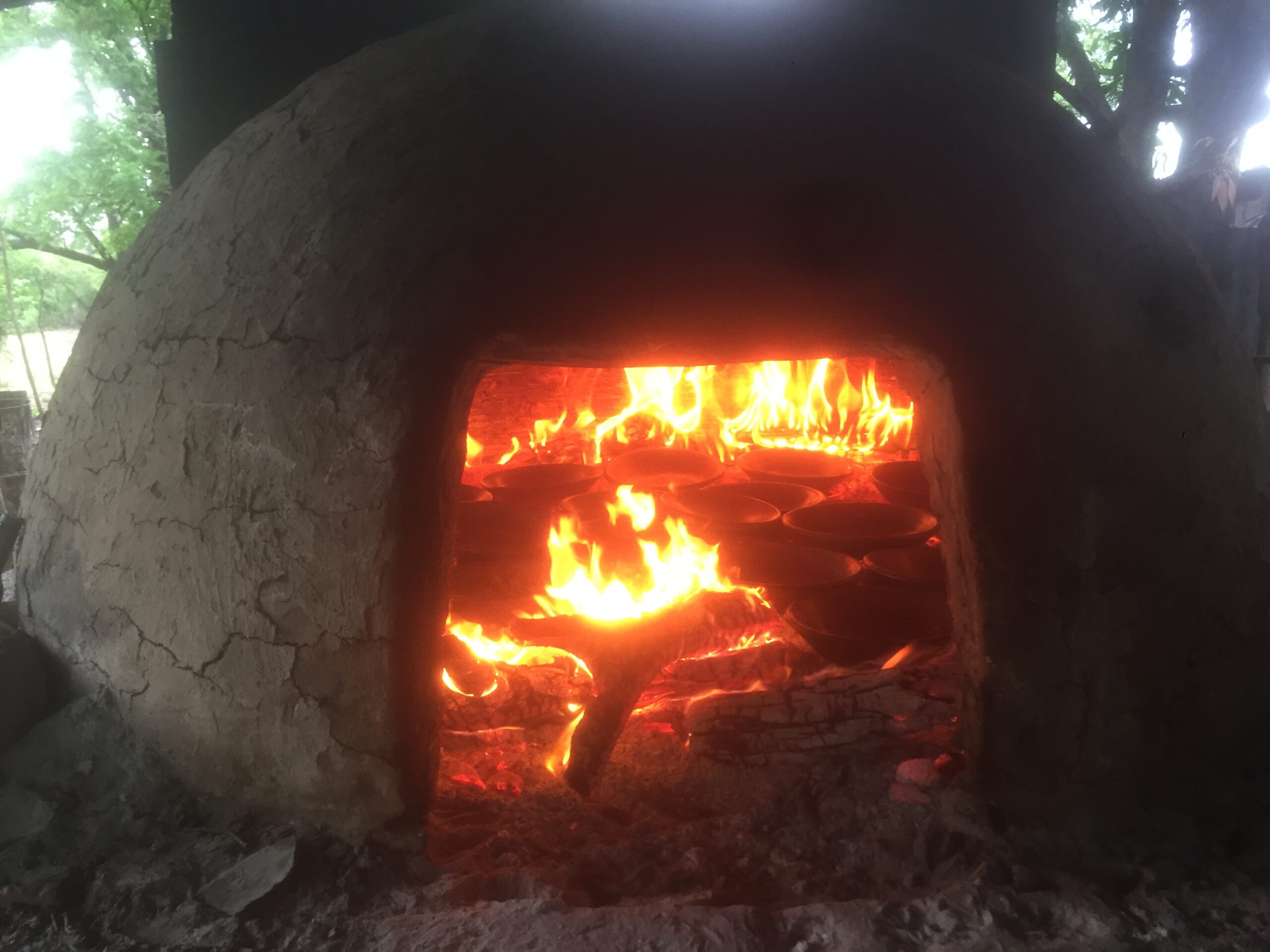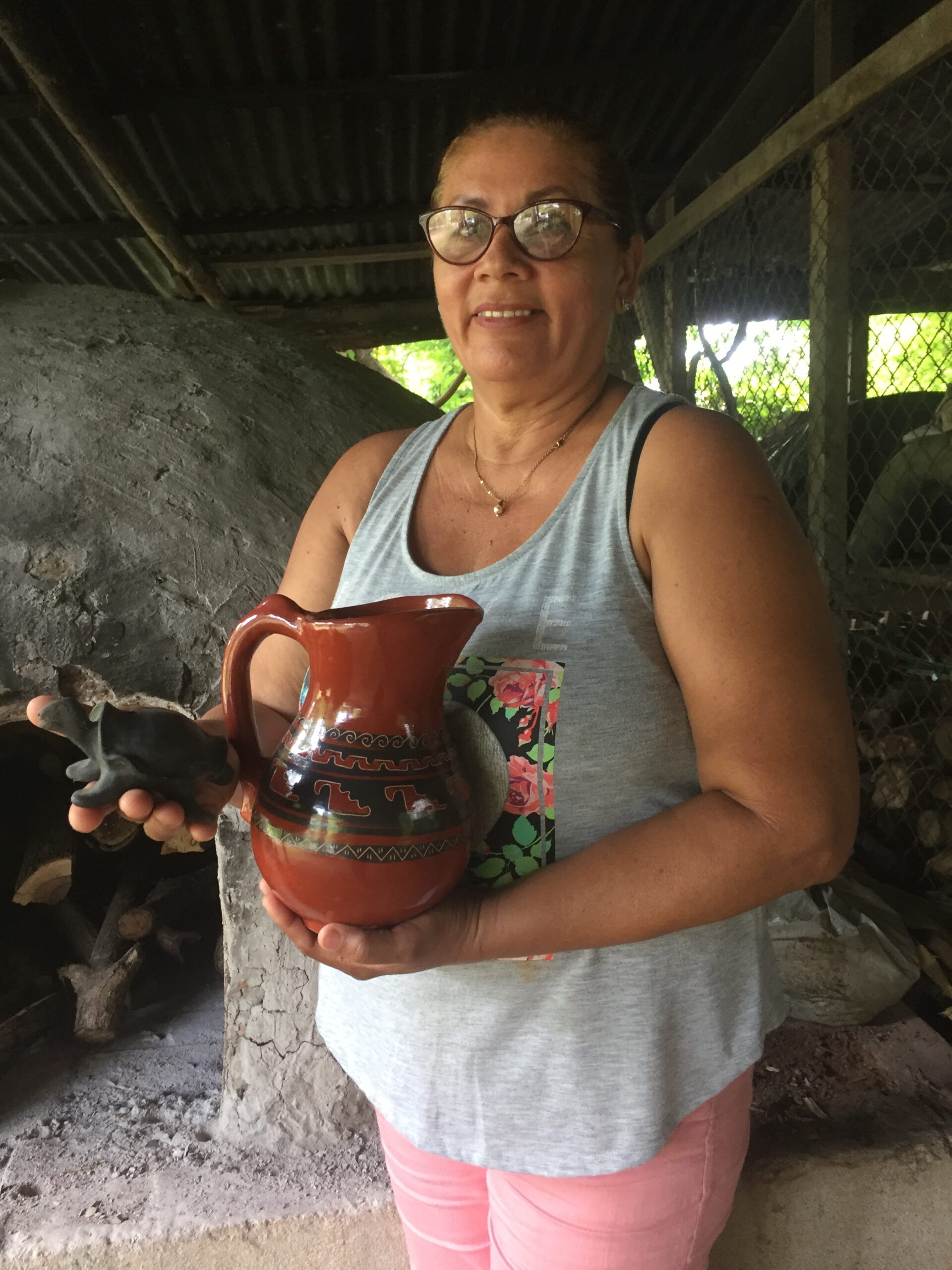Description
Cerámica Chorotega de las comunidades de Guaitil y San Vicente de los Cantones de Santa Cruz y Nicoya en la provincia de Guanacaste.
En esta zona, llamada la Gran Nicoya, la actividad alfarera se mantuvo durante miles de años; en investigaciones realizadas, se ha estimado que esta tradición tiene unos 4000 años de antigüedad, logrado perdurar y transmitirse de generación en generación. Guaitil y San Vicente, mantienen un gran arraigo en la producción alfarera artesanal de piezas utilitarias para la cocción y almacenaje de alimentos principalmente y donde la decoración de las piezas cerámicas fue parte de una evolución en la elaboración, la cual llegó posteriormente a alcanzar altos grados de complejidad y belleza en sus trazos.
Gracias a la alta demanda de cerámica utilitaria a finales de la década de los años 40 y 50 (debido a la escasez de utensilios de aluminio y metal, ligado a la Segunda Guerra Mundial), los pueblos de Guaitil y San Vicente se dieron a conocer a nivel nacional por sus tinajas y cacerolas. Posteriormente, para la década de los 90’s, con el boom turístico en la región, la fabricación de cerámica se configuró en la principal actividad económica de estas comunidades, realizada tanto por hombres como por mujeres.
Con el paso del tiempo, las técnicas de elaboración han tenido algunas modificaciones con respecto a la práctica original indígena, pero ésta, conserva esencialmente sus ingredientes principales: la arcilla y la denominada “arena iguana”, que le da forma a la vasija y el “curiol” pintura natural que le da vida y matices a las piezas, en rojo, blanco y negro (Pizarro y Marchena, 2009: 2).
Para ir levantando y dándole forma a la arcilla, se pueden usar varias técnicas; la más utilizada es el enrollado de tiras o rollos que se van incorporando a una base de arcilla, la base o molde se puede montar sobre una tabla circular puesta sobre el roll o torneta que gira, o un molde cerámico, ambas con la forma que tendrá el fondo de la vasija.
La cerámica chorotega es única en el mundo, cuenta con su respectiva denominación de origen desde 2019. Se identifican tres líneas o estilos de productos: Estilo tradicional, estilo chorotega renovado y estilo ecológico.
El estilo tradicional es caracterizado por productos utilitarios que permanecieron hasta mediados del siglo XX, asociados a las labores domésticas de mantener agua, cocinar y servir alimentos, y algunas figuras de origen precolombino como las múcuras; así como los comales y las tinajas de agua. En el estilo chorotega renovado se incorporan innovaciones creativas de las piezas de origen precolombino. Presenta réplicas exactas de piezas indígenas obtenidas de contextos precolombinos por saqueo de enterramientos o por referencias en libros de arqueología con piezas que mezclan formas y acabados estilísticos en combinaciones originales. El estilo ecológico es innovador incorporando motivos ecológicos, que surge a partir de los años 1960, cuando la industria alfarera empezó a convertirse al mercado turístico, impulsando una transición más hacia un estilo de dibujos literales de la naturaleza, con motivos de fauna como tortugas, colibríes y mariposas y motivos vegetales como flores y hojas.
La COOPESANGUAI, cooperativa que agremia artesanos que producen cerámica chorotega de estas dos comunidades, cuenta con 84 socios. Sin embargo, algunos de ellos no se encuentran activos y otros han tenido que cambiar de actividad para sustentar sus familias, sobre todo a partir de la pandemia del COVID 19, al caer las ventas y producción de cerámica.
Los interesados podrán obtener las artesanías de cerámica chorotega y ver y vivir todo el proceso de elaboración en las comunidades de Guaitil y San Vicente. En los talleres de los artesanos alfareros
y en sus pequeñas tiendas; también se cuenta con un ecomuseo, donde se representa toda la historia y proceso productivo al respecto y dispone de tienda. En las principales tiendas de artesanía ubicados en los principales centros turísticos del país.
La mayoría de los 84 artesanos miembros de COOPESANGUAI se pueden considerar maestros de este oficio; sin embargo, algunos de los más conocidos son: Nury Marchena, Maribel Sánchez, Elpidio Chavarría, Ilsa Chavarría, Porfirio Grijalba, Miguel Leal Vega, Derix Briceño Espinoza, Ermelinda Cascante Marchena, Harry García Grijalba, Jesús Villarreal Leiton, María Padilla Vega, Imelda Campos Chavarría, Junior Matarrita Leal. Todos ellos cuentan con el Sello COSTA RICA ARTESANAL.
english
Chorotega Ceramics
Chorotega pottery can be found in the communities of “Guaitil”, “San Vicente de los Cantones de Santa Cruz” and “Nicoya in the province of Guanacaste”. In this area, called the “Great Nicoya”, the pottery activity has been maintained for hundreds of years. Research has estimated that this tradition is about 4,000 years old, and has managed to endure and be passed on from generation to generation. They are deeply rooted in the production of handmade pottery for cooking and storing food, where the decoration of the ceramic pieces was part of an evolution that later reached high levels of complexity and beauty in its lines.
Thanks to the high demand for utilitarian ceramics in the late 1940s and 1950s (due to the shortage of aluminium and metal utensils linked to World War II), these towns became nationally known for their jars and pots. Later, by the 1990s, with the tourist boom in the region, pottery-making became the main economic activity in these communities, carried out by both men and women.
With the passage of time, the production techniques have undergone some modifications and essentially conserve their main characteristics: clay and the so-called “iguana sand”, which gives shape to the vessel, and the “curiol” natural paint that gives life and nuances to the pieces, in red, white and black (Pizarro and Marchena, 2009: 2). Various techniques can be used to lift and shape the clay; the most commonly used is the rolling of strips or coils that are incorporated into a clay base; the base can be mounted on a circular table that rotates, both with the shape that will form the bottom of the vessel.
Chorotega pottery is unique in the world and has had its own designation of origin since 2019. Three product lines or styles are identified: traditional, renewed Chorotega style and ecological style. The traditional style is characterised by utilitarian products that remained until the middle of the 20th century, associated with the domestic tasks of keeping water, cooking and serving food, and some figures of pre-Columbian origin such as the “múcuras”, as well as comales and water jars. The renovated Chorotega style incorporates creative innovations of pre-Columbian origin. It presents exact replicas of indigenous pieces obtained from pre-Columbian contexts by looting burials or by references in archaeological books with pieces that mix shapes and stylistic finishes in original combinations. The ecological style is innovative, incorporating ecological motifs, which emerged from the 1960s, when the pottery industry began to convert to the tourist market, encouraging a transition more towards a style of literal drawings of nature, with fauna motifs such as turtles, hummingbirds and butterflies, and plant motifs such as flowers and leaves.
COOPESANGUAI, a cooperative that brings together artisans, has 84 members. However, some of them are no longer active and others have had to change their activities to support their families, especially since the COVID 19 pandemic, when pottery sales and production fell. They can be found in the main craft shops located in the main tourist centres of the country.






Reviews
There are no reviews yet.